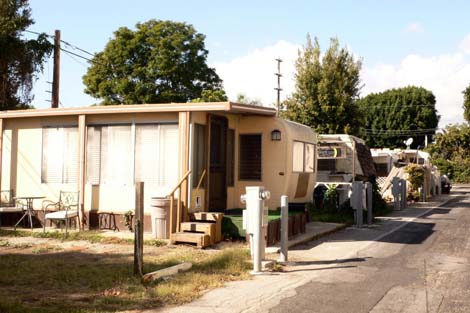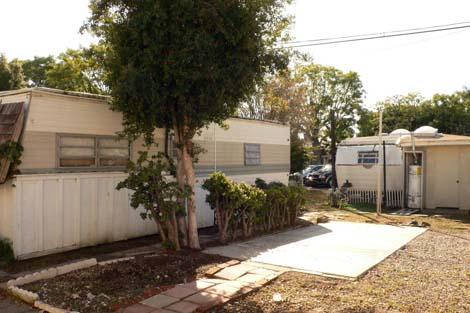| The LookOut columns | | What I Say |
| The LookOut columns | | What I Say |
|
|
 |
| Village Trailer Park (Photos by Frank Gruber) |
It seems to have been like a game of chicken. The new owners purchased the property knowing that the current zoning did not allow for their redevelopment of the property. Yet they proceeded to buy the land, and give notice to the tenants, on the premise that they would hold the land vacant.
This situation led to a fascinating moment at the City Council meeting. Community activist and growth-skeptic Zina Josephs told the council members that uniquely in this case they had the opportunity to stop a large development. Council Member Ken Genser asked what made the situation different. Ms. Josephs answered that in this case the council did not have to change the zoning -- i.e., the council could leave the developers with an unusable piece of land.
True enough, and I admire Ms. Josephs for her principled stand, but what she said was not the whole reality. As discussed already, the City doesn't want to see the residents evicted with nothing to show for it but a moral victory.
But there is also a question about the future: is it reasonable to expect the trailer park to last forever? Should it? That was the question a neighbor from one of the college streets asked. He wasn't wildly enthusiastic about new development, but he looked at the trailer park and questioned whether it was permanent. Having recently walked through the park, I have to ask the same thing.
 |
Now planning staff will start negotiations with the developers. As represented by Marc Luzzatto, the developers appear to be mindful of what Santa Monicans expect to see in new development, and at least to a degree solicitous of the needs of the current trailer park residents.
Both the Planning Commission and the City Council have criticized the developers' plans because of the size of the proposed apartments for displaced residents are only about 250 square feet. This is about the size of the typical mobile home, but that doesn't take into account the outside space available to tenants.
To remedy this, the commission and the council have recommended increasing the size of these apartments to 500 square feet. But I wonder if a little more indoor space is going to give the tenants what they want. I wonder if it might be better to get a good architect involved who could design a complex with the smaller units, but with more "outdoor room" space for each apartment. This might keep building costs down, and provide tenants the "indoor-outdoor" living they apparently now enjoy.
 |
But the issue that most concerns me about the developers' proposal is their inclusion of 40,000 square feet of "studio commercial" space -- i.e., more facilities creating jobs -- in their initial proposal. The development agreement is going to be on hold until the land use element update currently underway settles on principles for the industrial lands, but I hope that those principles do not include more job-creating uses, particularly on land that like the mobile home park is currently zoned residential.
All the benefits of building more housing near the job-creating office parks and post-production facilities that were built over the past twenty-five years will be lost if the City zones for more jobs. More than 8.5 million square feet of office space was built in Santa Monica between 1980 and 2000 -- more than 4.5 million square feet beyond what the 1984 general plan called for!
We'll be building residential for a long time before we catch up with that.
* * *
I need to say a word about Bob Gabriel. He was not only a Santa Monica institution, and a big piece of our institutional memory, but also my insurance agent. But not for all my policies. When I first asked him about getting insurance for our house, I told him I also had an old disability policy that I was sure should be updated, as I had been paying the premiums since I first became a lawyer. Bob looked over the policy. I was ready to switch to a policy he recommended, but he told me no, that the policy I had was great, and that I should stick with it.
Okay, maybe I shouldn't be so impressed with finding an honest businessman. I don't mean to imply an insult to other insurance agents. But that was the kind of guy Bob Gabriel was -- plainspoken, matter of fact, generous. Condolences to his wife, Louise, and the rest of his family.
|
If readers want to write the editor about this column, send your emails to The Lookout at mail@surfsantamonica.com . |
|
If readers want to write Frank Gruber, email frank@frankjgruber.net
The views
expressed in this column are those of Frank Gruber and do not necessarily
reflect the opinions of |
| Copyright 1999-2008 surfsantamonica.com. All Rights Reserved. |